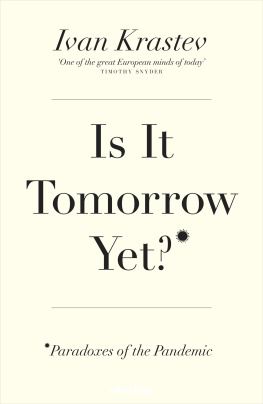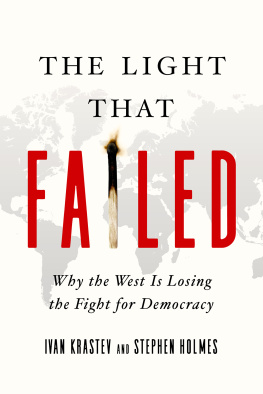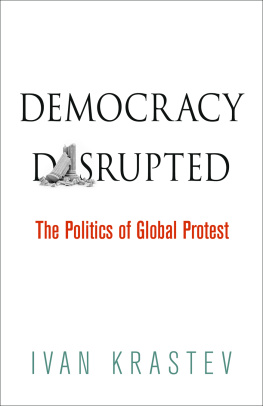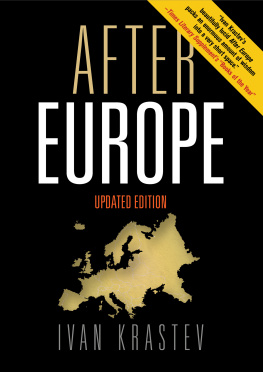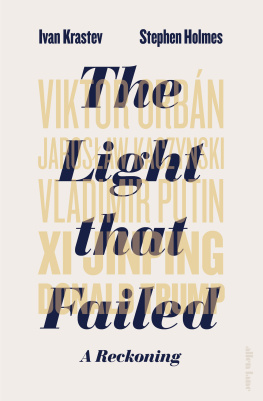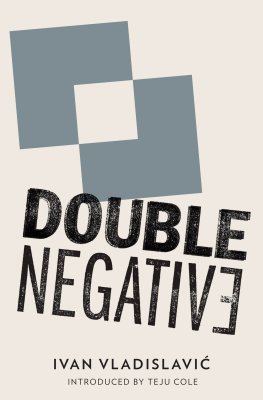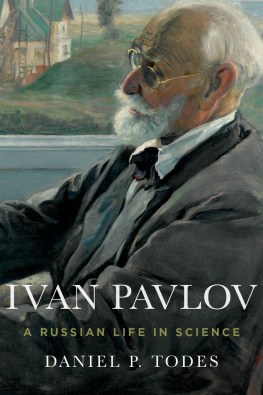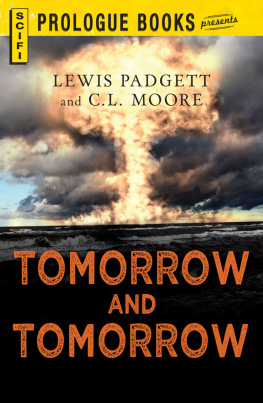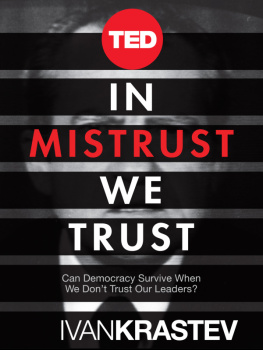Ivan Krastev - Is It Tomorrow Yet?
Here you can read online Ivan Krastev - Is It Tomorrow Yet? full text of the book (entire story) in english for free. Download pdf and epub, get meaning, cover and reviews about this ebook. year: 2020, publisher: Penguin Books Ltd, genre: Politics. Description of the work, (preface) as well as reviews are available. Best literature library LitArk.com created for fans of good reading and offers a wide selection of genres:
Romance novel
Science fiction
Adventure
Detective
Science
History
Home and family
Prose
Art
Politics
Computer
Non-fiction
Religion
Business
Children
Humor
Choose a favorite category and find really read worthwhile books. Enjoy immersion in the world of imagination, feel the emotions of the characters or learn something new for yourself, make an fascinating discovery.
- Book:Is It Tomorrow Yet?
- Author:
- Publisher:Penguin Books Ltd
- Genre:
- Year:2020
- Rating:3 / 5
- Favourites:Add to favourites
- Your mark:
- 60
- 1
- 2
- 3
- 4
- 5
Is It Tomorrow Yet?: summary, description and annotation
We offer to read an annotation, description, summary or preface (depends on what the author of the book "Is It Tomorrow Yet?" wrote himself). If you haven't found the necessary information about the book — write in the comments, we will try to find it.
Is It Tomorrow Yet? — read online for free the complete book (whole text) full work
Below is the text of the book, divided by pages. System saving the place of the last page read, allows you to conveniently read the book "Is It Tomorrow Yet?" online for free, without having to search again every time where you left off. Put a bookmark, and you can go to the page where you finished reading at any time.
Font size:
Interval:
Bookmark:

PENGUIN BOOKS
UK | USA | Canada | Ireland | Australia
New Zealand | India | South Africa
Penguin Books is part of the Penguin Random House group of companies whose addresses can be found at global.penguinrandomhouse.com.

First published by Allen Lane in 2020
Copyright Ivan Krastev, 2020
The moral right of the author has been asserted
Cover design: Keenan
ISBN: 978-0-141-99518-2
This ebook is copyright material and must not be copied, reproduced, transferred, distributed, leased, licensed or publicly performed or used in any way except as specifically permitted in writing by the publishers, as allowed under the terms and conditions under which it was purchased or as strictly permitted by applicable copyright law. Any unauthorized distribution or use of this text may be a direct infringement of the authors and publishers rights and those responsible may be liable in law accordingly.
To Boris, Lilli and Svetoslav Bojilov, and my family Yoto, Niya and Dessy with whom we spent several unforgettable weeks, living through a quarantine together and reflecting upon the coronavirus crisis that was unfolding before our eyes.
Man is the only known time machine.
Georgi Gospodinov, Time Shelter

Epidemics infect society with fear. Though they can bring out the best in people, they can also bring out the worst in governments. In Jos Saramagos novel Blindness, a man suddenly loses his sight, as does the doctor who examines him and a thief who steals his car, and in no time life descends into chaos. Fearful of the spread of the white sickness, the government takes draconian measures to halt the contagion. All those who are already blind and those who have had contact with them are rounded up and taken to a former mental asylum at the edge of the city. Any attempt to leave the hospital is met with lethal force from patrolling soldiers, petrified that they will also lose their sight. The asylum becomes more of a concentration camp than a hospital.
In the novels final pages, the epidemic abates as suddenly as it began, leaving people to wonder why they became blind. I dont think we did go blind, I think we are blind, blind but seeing, concludes one of the characters. Blind people who can see, but do not see. Saramago doesnt believe that epidemics transform society; in his view, they help us to see the truth about our societies. If he is right, the COVID-19 pandemic should have opened our eyes to the world we have been living in. It should have helped us to make sense of it.
The first thing that plague brought to our town was exile, notes the narrator in Camuss The Plague, and these days we have a decent sense of what he meant. A society in quarantine is literally a closed society. Many people cease working, they stop meeting their friends and relatives, they quit driving their cars, and they put their lives on hold.
The one thing that we absolutely cannot stop doing is talking about the virus that threatens to change our world for ever. We are imprisoned in our homes, haunted by fear, boredom and paranoia. Benevolent (and not-so-benevolent) governments closely follow where we go and whom we meet, determined to protect us from both our own recklessness and the recklessness of our fellow citizens. Unsanctioned walks in the park may elicit fines or even jail time, and contact with other people has become a threat to our very existence. The unsolicited touching of others is tantamount to betrayal. As Camus observed, the plague erased the uniqueness of each mans life as it heightened our awareness of our vulnerability and powerlessness to plan for the future. After an epidemic, all those still living are survivors.
But for how long will the memory of this unprecedented social experiment last? Could it be that in just a few years well remember it as a kind of mass hallucination caused by a shortage of space made up for by a surplus of time, as the poet Joseph Brodsky once described a prisoners existence?
The COVID-19 pandemic has turned out to be a classic grey swan event highly probable and capable of turning our world upside down, but nonetheless a huge shock when it arrives. In 2004, the US National Intelligence Council predicted that it is only a matter of time before a new pandemic appears, such as the 191819 influenza virus that killed an estimated 20 million worldwide, and that such an occurrence could put a halt to global travel and trade during an extended period, prompting governments to expend enormous resources on overwhelmed health sectors. In a 2015 TED Talk, Bill Gates predicted not only a global epidemic of a highly infectious virus, but also warned us that we were unprepared to respond to it. Hollywood also presented us with its own blockbuster warnings. But its no accident that there are no grey swans in Swan Lake; grey swans are an example of something predictable yet unthinkable.
Although great epidemics are, in fact, not such rare occurrences, for some reason their arrival always surprises us. They reset our world in a similar way to wars and revolutions, yet these other things stamp themselves on our collective memory in a manner that epidemics somehow do not. In her marvellous book Pale Rider, the science writer Laura Spinney shows that the Spanish flu was the most tragic event in the twentieth century but is now mostly forgotten. A century ago, the pandemic infected a third of the worlds population, a staggering 500 million people. Between the first recorded case on 4 March 1918 and the last in March 1920, the pandemic wiped out between 50 and 100 million people. In terms of loss of life from a single event, it surpassed both the First World War (17 million dead) and the Second World War (60 million dead) and may have killed as many people as both wars put together. Yet, as Spinney notes, When asked what was the biggest disaster of the twentieth century, almost nobody answers the Spanish flu. More surprisingly, even historians seem to have forgotten the epidemic. In 2017, WorldCat, the worlds largest library catalogue, listed roughly 80,000 books on the First World War (in more than forty languages) but barely 400 on the Spanish flu (in five languages). How can it be that an epidemic that killed at least five times more people than died in the First World War has resulted in 200 times fewer books? Why do we remember wars and revolutions but forget pandemics, even though the latter change our economies, politics, societies and urban architecture just as fundamentally?
Spinney believes that one key reason is that its easier to count those killed by bullets than those who die from a virus, and the present controversy regarding the mortality rate of COVID-19 seems to suggest that she is right. The other, more fundamental, reason is that its difficult to turn a pandemic into a good story. It is impossible to retell it as a clash of good and evil. It lacks a plot and a moral. In 2015, the psychologists Henry Roediger and Magdalena Abel suggested that people tend to remember only a small number of salient events from any situation, namely those referring to beginning, turning and end points. Its very hard to tell the story of the Spanish flu (or of any other great epidemic, for that matter) with this narrative structure; epidemics are like Netflix series, where the end of one season is merely a hiatus before the next one. The relationship between the epidemic and war resembles the relationship between some modernist literature and the classical novel. The strangeness of the pandemic experience is that everything changes but nothing happens. We are asked to save humanity by staying home and washing our hands. As in a modernist novel, all the action is in the mind of the narrator.
Font size:
Interval:
Bookmark:
Similar books «Is It Tomorrow Yet?»
Look at similar books to Is It Tomorrow Yet?. We have selected literature similar in name and meaning in the hope of providing readers with more options to find new, interesting, not yet read works.
Discussion, reviews of the book Is It Tomorrow Yet? and just readers' own opinions. Leave your comments, write what you think about the work, its meaning or the main characters. Specify what exactly you liked and what you didn't like, and why you think so.

